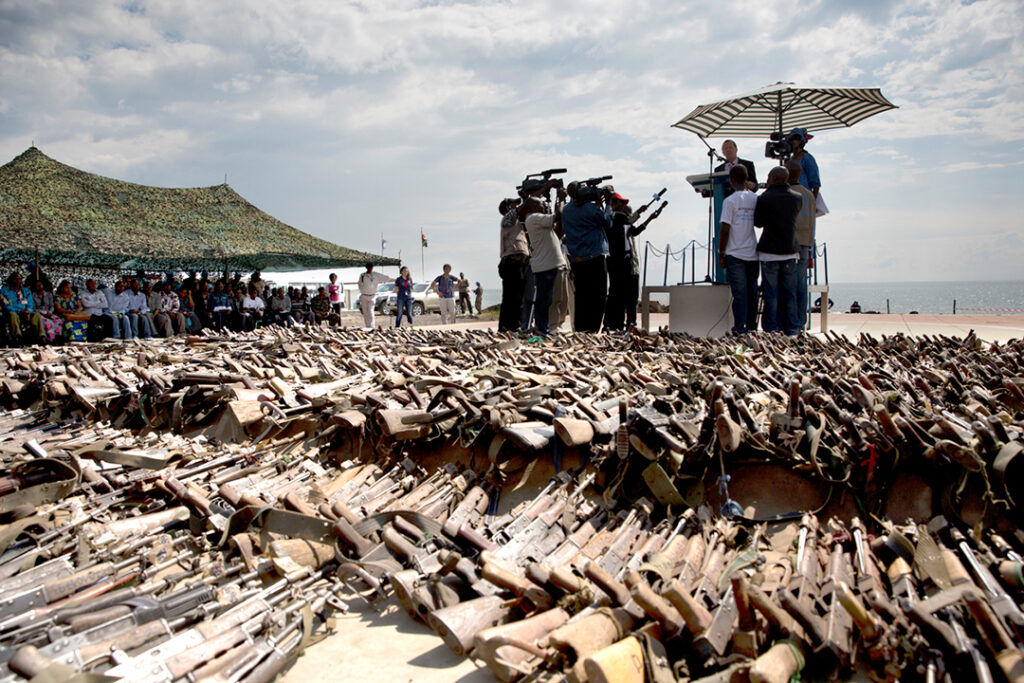ADF STAFF
When the Islamist extremist group Ansar al-Sunna began spreading terror in the Cabo Delgado province of northern Mozambique in 2017, its fighters brandished machetes. Today, the insurgents carry assault rifles and rocket-propelled grenades (RPGs).
Battlefield losses are a major reason for this.
In 2019, when the insurgency in Mozambique was growing in strength and sophistication, its leaders pledged allegiance to the Islamic State Central Africa Province. Soon after, posts on ISIS social media platforms showed off assault rifles, dozens of ammunition magazines and several RPGs — all captured from the Mozambican military.
Militant groups throughout the continent have armed themselves in this way.
“Contingent-owned equipment (COE) loss has become a critical vulnerability for national armies and peace operations in Africa,” arms expert Eric G. Berman recently wrote for the Africa Center for Strategic Studies. “Non-state armed groups have regularly targeted and overrun peacekeepers and national armed forces to seize lethal and non-lethal material.”
In a September 2021 study, Berman highlighted a 2018 attack on a military base in Nigeria in which militants killed more than 60 Soldiers and took three gun-trucks along with arms, ammunition and uniforms.
Attacks like this one have armed and emboldened extremist groups. At least 714 Nigerian Soldiers have been killed by terrorists in the last 18 months, according to an April 10, 2022, report by Nigerian newspaper The Punch.
“They [the terrorists] are already taking the battle to the armed forces,” retired Brig. Gen. John Sura told The Punch. “Nobody is happy that people, who have risen to protect Nigerians, are losing their lives.”
Over the past 10 years in Africa, armed groups have targeted and taken millions of rounds of ammunition, thousands of small arms and light weapons, hundreds of heavy weapons systems, vehicles and motorcycles, uniforms, communications equipment, and fuel.
“Armed groups use this material against peacekeepers and armed forces in complex ambushes, perpetuating the cycle of munitions loss,” Berman wrote. “Platoons have been targeted at outposts. Companies have been targeted at forward operating bases. Battalions have been targeted at sector headquarters. And dozens of supposedly secure sites, both small and large, have been overrun and their stores looted.”
Berman leads the Safeguarding Security Sector Stockpiles Initiative and before that was director of the Small Arms Survey, which conducted a joint study with the African Union Commission as part of its Silencing the Guns initiative.
In addition to battlefield loss, the study revealed that illicit weapons came from national stockpiles and from peacekeeping forces due to corruption, mismanagement and theft.
Among the best practices for securing weapons and preventing them from falling into enemy hands, multiple studies emphasized these areas of improvement:
- Security around weapons depots and for transportation of stockpiles.
- Permanent records in a registry of weapons, ammunition and related material for all military and peacekeeping forces. This includes weapons-marking programs, pre-deployment assessments, post-deployment recording of stocks and investigations into reported losses.
- Weapons recovery programs — amnesties, exchanges, militant reintegration.
- Participation in international information-sharing platforms to access weapons-trafficking intelligence.
- Sharing regional and sub-regional arms-control standards.
Experts also highlighted the need for leadership to prioritize morale, transparency, payment and benefits for Soldiers to combat corruption and theft that can be endemic to military and peacekeeping operations.
Originally adopted in 2013 by the AU heads of state, the Silencing the Guns initiative aspired to be completed in 2020. But by the end of that year, the AU voted to extend it through 2030.
The problem?
Since 2013, conflicts within countries have become more common than conflicts between countries, according to Henry Otafiire, a research fellow at Great Lakes Institute for Strategic Studies.
“As clock ticked towards the 2020 deadline, it was increasingly becoming clear that the targets set then were far from being realized. One of the reasons for the failure is that the 2020 goal was too ambitious given the number of conflicts on the continent,” he wrote on his organization’s website in March 2022.
“As the AU embarks on the new deadline of 2030, the AU must put in place systemic interventions that address strategic bottlenecks that lead people to violent conflicts, including poverty, historical injustices, inequality, unemployment, climate change and illegal financial flows. Corruption should be addressed, too, for guns to be silenced.”

